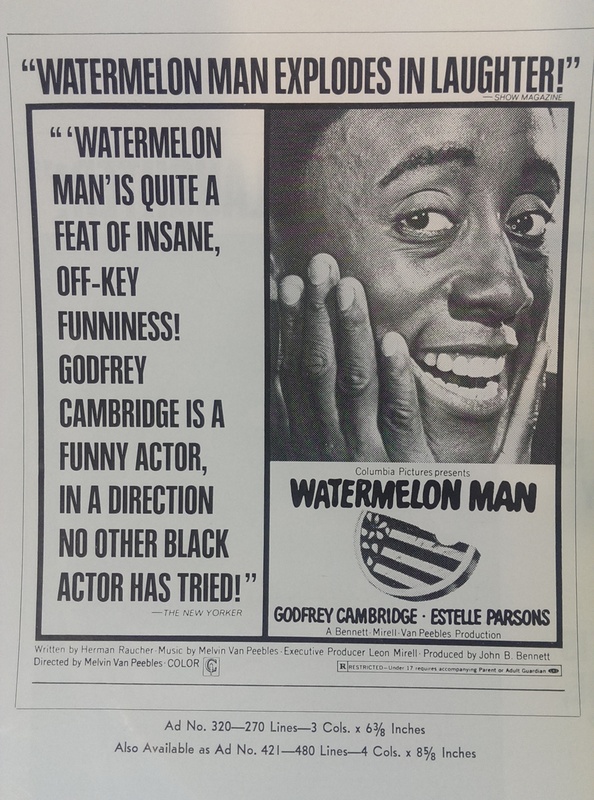Watermelon Man - Ad Supplement
Dublin Core
Title
Subject
Description
In this advertising supplement for Watermelon Man, the film’s leading actor, Godfrey Cambridge, is pictured on the right, with accompanying critic reviews to the left of the page, and the movie’s title and “logo” pictured below. The ad’s choice of imagery and text are significant in relation to the context of the film as they implicitly reflect many of the same racist histories and ideologies that the story critiques, including the history of the coon caricature and the idea of viewing the black male actor as solely entertainer. Within this advertisement, Van Peebles’s social commentary is compromised by Hollywood’s efforts to remain neutral to the politics of the time.
The image shows a close-up of Godfrey Cambridge, who is pictured smiling intensely and holding his face, gesturing toward delight and happiness. This sort of imagery reflects that of the historical caricature of the “coon.” The coon—like the mammy and the pickaninny—was one of the most prominent stereotypical racist constructions. The coon character portrayed black people as lazy, unintelligent, and buffoonish. As Dr. David Pilgrim describes in his summary of the character, the coon was “one of the stock characters among minstrel performers… The coon’s goal was leisure, and his leisure was spent strutting, styling, fighting, avoiding real work, eating watermelons, and making a fool of himself.” The film makes the connection to the coon character obvious, as Cambridge’s character is referred to as the “Watermelon Man” in the title, and similar racist remarks referring to black people’s assumed extreme appetite for watermelon are made throughout the movie. Moreover, as Cambridge’s intense smile and over-exaggerated gesture visually portray him as dim-witted and buffoonish, this connection to the coon character is reiterated. The text surrounding Cambridge further conveys this characterization, as the advertisement highlights reviews that comment on the comedy of Cambridge’s acting role. They describe the film as “a feat of insane, off-key funniness,” a movie that “explodes in laughter.” Furthermore, the reviews refer to Cambridge as “a funny actor, in a direction no other black has tried.” What’s interesting about this comment in relation to the others is the fact that it simultaneously acknowledges Cambridge’s oppositional performance as a black actor performing in whiteface to forward a political satire, while still primarily focusing on the comedic aspect of his role in the film. Because these reviews all concentrate on the comedy presented in the film, Cambridge’s role as the mobilizer of the film’s social commentary is reduced down to the humor he uses to present this commentary. By focusing on the humor in Cambridge’s act and virtually ignoring his role as the mobilizer for the film’s social critique, the advertisement paints him as a sort of minstrel performer, whose struggles as a black man are then taken lightly as they are framed as solely entertaining acts. Thus, by referring to the history of the coon in promoting the film, the social significance of Watermelon Man—that is, its political acknowledgement and critique of the prevailing racism within society—is negated by the advertisement’s choice of text and image.
Melvin Van Peebles’s efforts to forward a political agenda through a Hollywood-produced film marks Watermelon Man as one of a kind. As Racquel Gates argues, Watermelon Man “stands as a testament to Van Peebles’s difficult, but ultimately successful, ambition to criticize Hollywood’s and society’s racism ‘from the inside out’” (“Subverting Hollywood from the Inside Out” 9). As black audiences often demanded a great deal from black-produced films, it was hard for black filmmakers to balance the want for authentic representation, as well as accompanying an anti-racist agenda, and the need to cooperate with Hollywood with regards to producing a profitable film. Given such constraints, Gates further argues that “Perhaps most impressive is the way that Van Peebles used the very tools of Hollywood representation, such as conventions around whiteness and American identity, to reveal deeper, white privilege, and Hollywood” (12). When such an accomplishment is compared to how the film is actually promoted, it is clear to see that Van Peebles’s work is compromised. Hollywood’s promotion implicitly perpetuates the idea of viewing the black male actor as solely entertthus it reduces Watermelon Man’s voice for advocating racial equality.
Racquel. “SUBVERTING HOLLYWOOD FROM THE INSIDE OUT: MELVIN VAN PEEBLES'S WATERMELON MAN” Film Quarterly, Vol. 68, No. 1 (Fall 2014), pp. 9-21.
Pilgrim, David, Dr. "The Coon Caricature." JCM: The Coon Caricature. Jim Crow Museum, Oct. 2000. Web. 20 Apr. 2015. <http://www.ferris.edu/htmls/news/jimcrow/coon/>.
Citation
Catalog Search
Search for related records in these catalogs:
